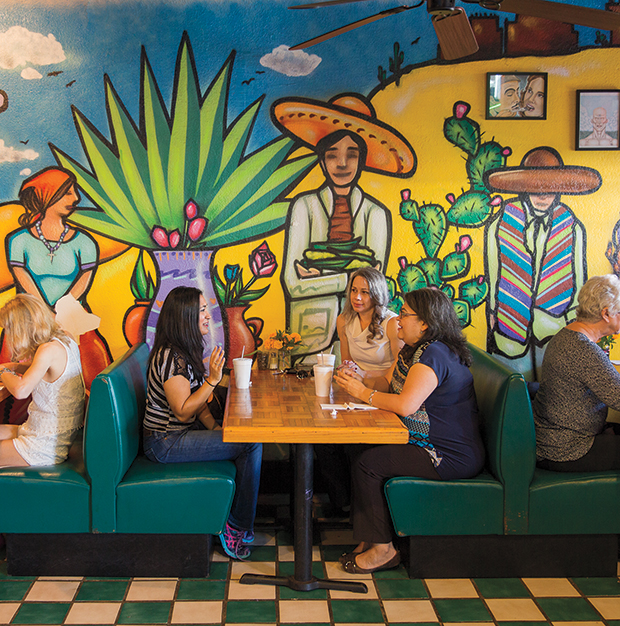
The Rio Grande Grill in Harlingen specializes in Tex-Mex made with smoked barbecue.
Rio Grande Valley Byways
The drive from McAllen east to Brownsville on Business 83 and US 281 is approximately 60 miles, although with its many small towns, sights, and stoplights, the trip feels much longer. For tourist information, visit McAllen, Weslaco, Harlingen, and Brownsville websites.
Pharr
The Junction Cafe is at 11 S. Cage Blvd. Call 956/783-4885.
The restored neon sign at the former Valley Fruit Company (now the Food Bank of the Rio Grande Valley) is at 724 Cage Blvd.
Piñateria Jasmine is at 2 N. Cage Blvd. Call 956/569-7518.
San Juan
Gonzalez Custom Boots is at 107 W. US 83. Call 956/483-4377.
Weslaco
The Villa de Cortez, Jose’s Cafecito, and Storybook Garden are at 260 S. Texas Blvd. Call 956/969-3100 (Villa de Cortez), 956/968-5057 (Jose’s Cafecito), and 956/968-7323 (Storybook Garden); www.villadecortez weslaco.com and www.thestorybookgarden.com.
Harlingen
Rio Grande Grill is at 417 W. Van Buren Ave. Call 956/423-1817.
Brownsville
Visit the Mitte Cultural District website for details about the Gladys Porter Zoo, the Children’s Museum of Brownsville, and other sites.
Historic Brownsville Museum (in the Mitte) is at 641 E. Madison St. Call 956/548-1313.
Scale House Visitor Center (in the Mitte) is at 1700 E. 6th St. Call 956/546-3898.
Costumes of the Americas Museum (in the Mitte) is at 501 E. Ringgold St. #5. Call 956/547-6890.
Bici Bistro is at 536 E. 12th St. Call 956/621-9597.
Her point was well-taken. Since we first moved to South Texas a decade ago, I’ve done my fair share of traveling. And don’t road trips typically involve some far-flung locale, rather than one’s own backyard?
Still, I had an idea. What if instead of traveling in the fast lane of the expressway, I traveled on the Valley’s “old” highways—today’s “business” routes—where I’d stop for red lights in each new town, rather than zipping by in a blur of billboards and chain restaurants?
And while our sedan isn’t the shiny red convertible of the iconic road trip, it didn’t much matter. Given that the small cities of the Valley are strung close together like a string of pearls, I wouldn’t be doing much high-speed cruising, anyway. But as I pulled out of our driveway in McAllen one cloudless winter morning and headed east on old US 83, I did have the most important ingredient of any successful road trip: A quest for discovery.
At my first stop in Pharr, near the intersection of US 281 and Business 83, the vertical “Junction Cafe” sign beckoned from the highway just as it has since 1939, when the Tex-Mex diner served its first customers. Back then, the six-lane expressways we now call US highways 83 and 281 didn’t exist, of course; travelers took the “old” routes. These days, the old highways are lined with historic buildings, peculiar sights, and interesting attractions that offer a wealth of stories about the Rio Grande Valley.
I quickly learned, though, that Pharr’s Junction Cafe is not named for its location at the junction of two highways. That became apparent the moment I stepped inside and saw train-themed decor ranging from Lionel model trains to a vintage, striped conductor’s hat. In the early 1900s, Pharr was among many Valley cities that sprang up along the new St. Louis, Brownsville, and Mexico Railway. US 83, then known simply as “the main street,” was built parallel to the railroad, giving farm trucks a path to the freight depots.
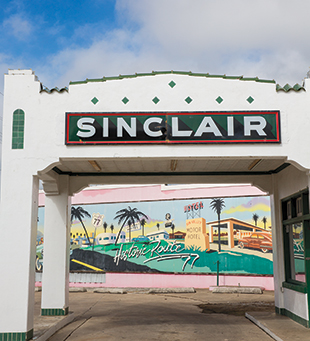
More than a dozen murals in Harlingen, including this one by artist John Aretakis at 202 N. Commerce, depict aspects of the Valley’s history.
A block north, the former Valley Fruit Company has undergone an even grander reinvention. In the 1950s, the company employed 1,500 workers at its 16-acre warehouse complex, and its neon, art deco sign featuring two gleaming tomatoes became a quintessential Valley landmark. But after the company closed shop in the 1990s, the campus fell into disrepair. Eventually, the Food Bank of the Rio Grande Valley purchased the main warehouse and undertook a massive restoration project. The neon sign was painstakingly restored in 2012, along with the rest of the building, which is now in the National Register of Historic Places. Omar Rodriguez, the Food Bank’s communications director, told me there are plans for a museum, and a community garden here is already burgeoning with fresh produce.
The 12 miles before my next planned destination in Weslaco led past a string of smaller communities that developed to meet the needs of the Valley’s early-20th-Century farms as well as the laborers employed at them. On these single-block main streets, thrift is not a lost art. It’s still possible to have a dress mended, a typewriter repaired, or a pair of boots repaired or made from scratch. For custom boots, you’ll need to wait a few weeks—that’s how long cobbler Sergio Gonzalez said it takes to complete a pair when I dropped in at his San Juan workshop, Gonzalez Custom Boots.
If downtown San Juan speaks to the economy of farmworkers squeezing the most out of every paycheck, Weslaco’s opulent Villa de Cortez hotel proclaims the Gilded Age affluence of the Valley’s newly arrived landowners and developers. From 1900 to 1930, the population of Hidalgo County grew from 6,350 to 77,000, and the price of land rocketed from 25 cents an acre to more than $300. The zenith of this pre-Depression boom occurred on December 31, 1928, when the Villa de Cortez opened for business with a lavish New Year’s Eve gala.
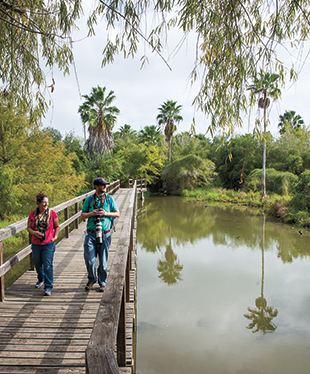
Birders flock to the Frontera Audubon nature park in Weslaco and add to their life lists.
But the restored Spanish Colonial-style landmark is also open to the general public thanks to its lively first-floor Mexican restaurant, Jose’s Cafecito. You can also see the Cortez by visiting the Rio Grande Valley’s only independent children’s bookseller, The Storybook Garden, which offers an expertly curated selection of children’s and adult literature, with frequent readings by local authors. Once again, the Villa de Cortez is a center of the Valley’s cultural life.
As I continued traveling east on Business 83, I realized how famished I was. Lucky for me, my next stop was the Rio Grande Grill in Harlingen.
The outside of the restaurant features a colorful mural of a Georgia O’Keeffe-inspired cow’s skull, which gave me some inkling of the funky vibe inside. “We’re a barbecue joint first and a Mexican restaurant second,” co-owner Daniel Wright told me when he greeted me at the register. He was referring not to the relative importance of each tradition but rather to the process in the kitchen: Daniel smokes the meats for about 18 hours, and then Chef Stefania Trimboli-Wright—his wife and co-owner—incorporates the fruits of his labor into innovative takes on traditional Mexican cuisine. The restaurant opens at 11 a.m. and closes when the food runs out (usually around 2 or 3 in the afternoon), and then the whole process begins again.
While a musician strummed a guitar in the corner, Daniel brought a feast to my table: tortilla soup, brisket, sausage, pulled pork, rice, beans, potato salad, and the day’s special, enchiladas gobernador, an out-of-this-world concoction of shrimp wrapped in corn tortillas with smoked poblano salsa. Just when I thought I couldn’t eat another bite, Daniel offered me a scoop of house-made vanilla ice cream topped with grated lime zest and, well, how could I resist?
Stefania invited me to visit the downtown Harlingen Farmer’s Market later in the day, when she would be doing a cooking demonstration as part of the market’s regular Saturday lineup. When I arrived, I found her preparing a salad with ingredients she’d gathered from the many vendors, including delicate squash blossoms and another edible flower called cow’s pea. The market takes place against the backdrop of a nearly block-long mural by local artist Ben Varela, which depicts the Valley’s cultural and musical heritage. This mural is one of more than a dozen murals found throughout the city. As I window-shopped at the many boutiques, antiques shops, and old-time candy stores, I particularly admired a colorful mural by Weslaco artist Brett Oberthaler called Downtown Harlingen: Where the Past Is Present, which chronicles seven historic buildings that have been restored and repurposed.
After Harlingen, Business 83 came to an inconspicuous end, so I headed back to US 281, the same highway I’d crossed in Pharr. The highway navigates a southerly route, following the loops of the Rio Grande through farmland and wildlife refuges, then makes a straight shot into the heart of my last destination of Brownsville.
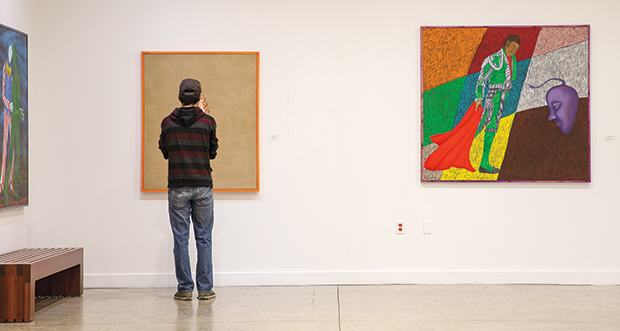
The Brownsville Museum of Fine Art offers fresh perspectives on the Valley’s culture.
I followed the old train tracks from the historical museum into the Mitte Cultural District, a sprawling campus that includes a zoo, art museum, auditorium, and children’s museum. To help orient myself, I dropped in to the Visitor Center, which occupies the former Scale House, where traders weighed produce before loading it onto the railroad cars. These days, the building is a stop on Brownsville’s Linear Park, a nine-mile bike trail that follows the tracks from downtown to the Palo Alto Battlefield National Historical Park, which preserves and interprets the site of the first battle of the U.S.-Mexican War. On Saturday mornings, the park hosts another farmers market, part of a community-wide initiative to promote cycling and healthy living.
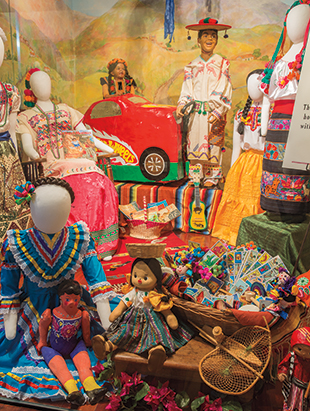
Costumes of the Americas Museum in Brownsville’s Mitte Cultural District.
With the sun dipping low on the horizon, I headed into downtown, where a wheel-shaped sign for the Bici Bistro caught my eye. The restaurant is housed in a former dry-goods store that sold arms during the Mexican Revolution, but skylights added in the most recent restoration imbue a modern feel to the structure. The airy atmosphere complements the menu’s emphasis on healthy options. I ordered a delectable vuelve a la vida cocktail with shrimp, oysters, calamari, and fish in a light tomato sauce. The name translates to “return to life,” which seemed fitting after a day spent visiting historic places that have not only been preserved but also made new again for future generations.
As for the “bici” in the bistro’s name? An avid cyclist, owner Jesus Treviño stores a fleet of bicycles in the basement, and in addition to running his bistro, he offers historical tours of downtown Brownsville. This gave me another idea: What if my next Valley road trip were on two wheels instead of four?








